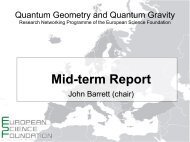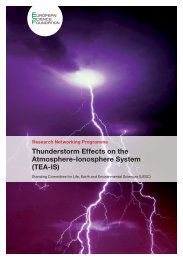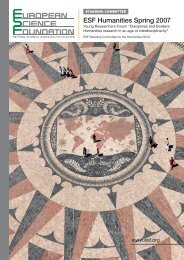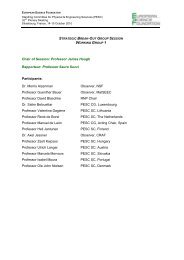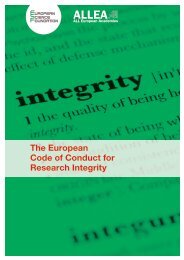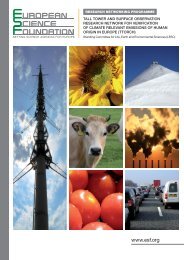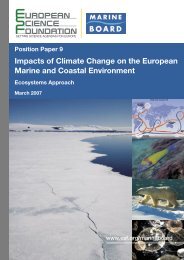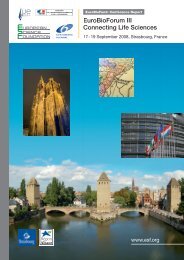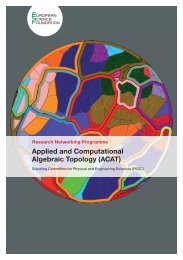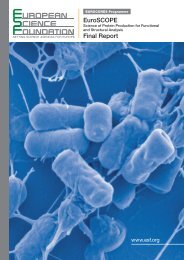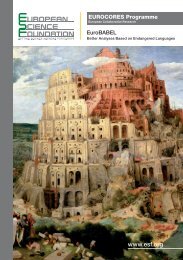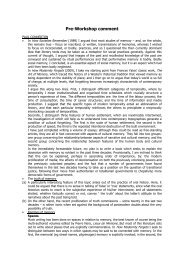European Peer Review Guide - European Science Foundation
European Peer Review Guide - European Science Foundation
European Peer Review Guide - European Science Foundation
You also want an ePaper? Increase the reach of your titles
YUMPU automatically turns print PDFs into web optimized ePapers that Google loves.
for their Individual Research Programmes while for<br />
Career Development Programmes this was 11 out of<br />
19 organisations. For both types of instruments, the<br />
size of the review panel depended on factors such as<br />
the number and length of the proposals submitted and<br />
the grant durations and amounts.<br />
• Reader System (see §4.5) is not routine across<br />
the two programmes but can be used for specific<br />
cases such as short-term fellowships or smallscale<br />
grants.<br />
Results from the ESF Survey Analysis Report on <strong>Peer</strong><br />
<strong>Review</strong> Practices showed that 4 out of 27 respondents<br />
use it for Individual Research Programmes while,<br />
similarly, 3 out of 25 respondents use it for Career<br />
Development Programmes 62 .<br />
• Right to Reply:<br />
Applicants are provided the right to comment<br />
on individual/remote reviewers’ reports, before<br />
the review panel or committee makes a selection,<br />
prioritisation or ranking of proposals (see<br />
§4.7.4).<br />
For calls that are continuously open or have<br />
fixed collection dates during the year, instead<br />
of a right to reply, the applicant can submit the<br />
proposal again, taking the individual/remote<br />
reviewers’ and panel reports into consideration.<br />
According to the ESF Survey Analysis Report on<br />
<strong>Peer</strong> <strong>Review</strong> Practices, from 30 respondents,<br />
16 organisations do not use the right to reply for any of<br />
their instruments, 4 organisations use it across all their<br />
instruments and 10 organisations use it for some of<br />
their instruments. For Individual Research Programmes,<br />
7 out of 27 respondents use the right to reply while<br />
for Career Development Programmes 7 out of 25<br />
respondents use it. This is an element that can add<br />
robustness and reliability to the process 63 .<br />
• The use of ‘consensus’, ‘ranking’, or<br />
prioritisation meetings between the<br />
individual reading and the review panel<br />
(See §4.8.2).<br />
5.2.3 Conflict of interest<br />
According to survey results, in response to the<br />
question “How is a possible bias/conflict of interest<br />
identified on the side of the reviewers in this<br />
Instrument?” the following table illustrates the<br />
responses provided for Individual Research<br />
Programmes and Career Development Programmes<br />
respectively (see table).<br />
5.2.4 Timelines<br />
The timeline (from launch of the call until the final<br />
decision, including the final communication to<br />
the applicants) for both Individual Research and<br />
Career Development Programmes should be limited<br />
to a maximum of one year. Other timelines can be<br />
adapted depending on the nature and number of<br />
proposals submitted; the duration and amount of<br />
the grant; and whether the call is a regular or an<br />
exceptional64 one.<br />
5.3 Processing of applications<br />
Depending on the number of proposals submitted,<br />
an organisation can opt to make a preliminary<br />
selection of proposals, which is commonly based<br />
on either an outline or full proposal. For larger<br />
Individual Research Programmes, applicants may<br />
submit the outline proposal first, followed by selection<br />
and invitation to submit a full proposal. It must<br />
be noted that such a process lengthens the timeline<br />
of the call. Another possibility is to ask the applicant<br />
to submit both an outline and full proposal<br />
at the same time. The preliminary selection, generally<br />
made by either individual/remote reviewers or<br />
review panel members, will then be based only on<br />
the outline proposal.<br />
Submission of outline proposals is appropriate<br />
for the first stage of a call when there are a great<br />
many project proposals submitted, while full proposals<br />
are suitable in a second stage when a reduced<br />
number of applicants apply. In this way the quality<br />
of the evaluation process improves.<br />
The practice of preliminary selection may appear<br />
to be less commonly used for Career Development<br />
Programmes because of the greater variability<br />
among those programmes, which can tend<br />
53<br />
<strong>European</strong> <strong>Peer</strong> <strong>Review</strong> <strong>Guide</strong><br />
62. See <strong>European</strong> <strong>Science</strong> <strong>Foundation</strong> (2010b), ESF Survey Analysis<br />
Report on <strong>Peer</strong> <strong>Review</strong> Practices, §4.2.2, in particular Question 102,<br />
Table 4.5.<br />
63. See <strong>European</strong> <strong>Science</strong> <strong>Foundation</strong> (2010b), ESF Survey<br />
Analysis Report on <strong>Peer</strong> <strong>Review</strong> Practices, in particular Section 3.8,<br />
Questions 55 and 58, Tables 3.35 and 3.37.<br />
64. As an example, 500 submissions for a four-year research grant<br />
may require longer timeline; while 100 submissions for a first<br />
postdoctoral fellowship of two years could be managed faster.<br />
Moreover, duration of the decision making process is important<br />
in postdoctoral grant programmes in that as a usual practice<br />
candidates just after receiving or while finishing a PhD, may<br />
submit proposals to several host organisation and, if the timeline is<br />
too long, optimal opportunities and matching may be lost.



